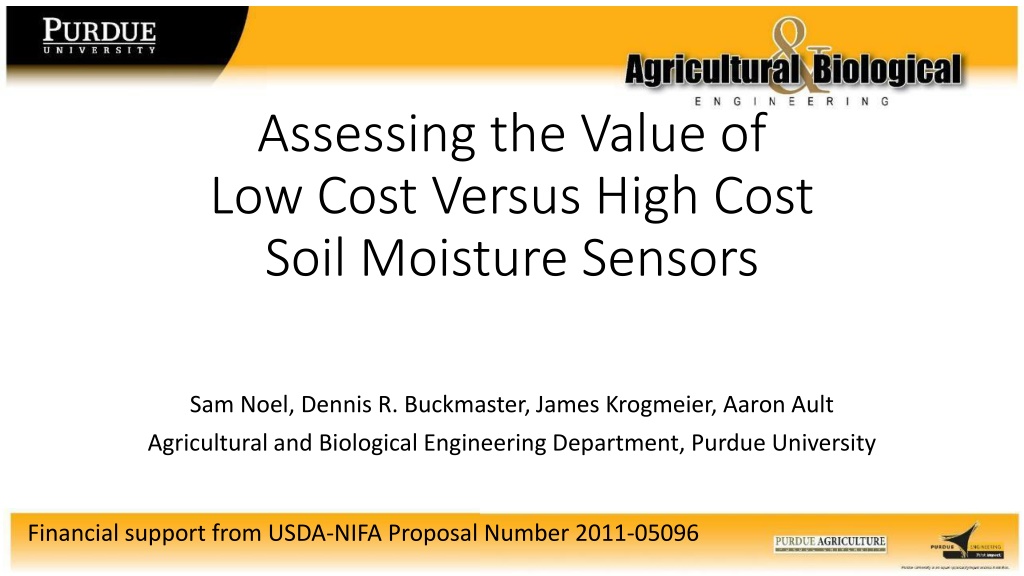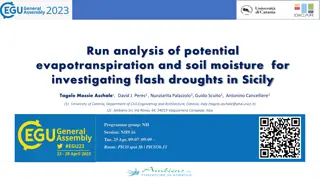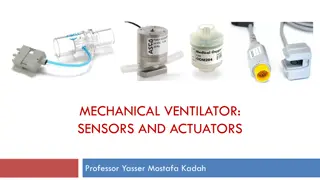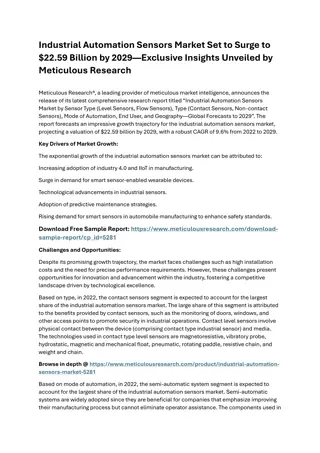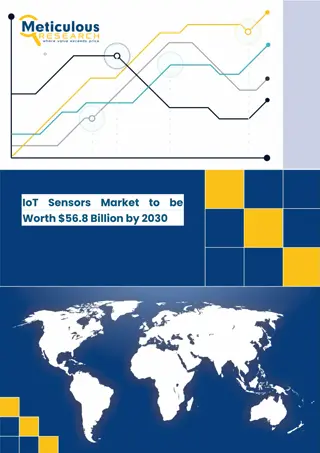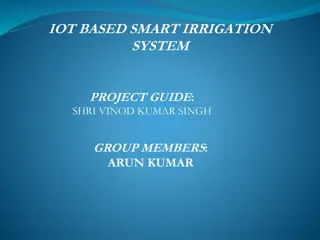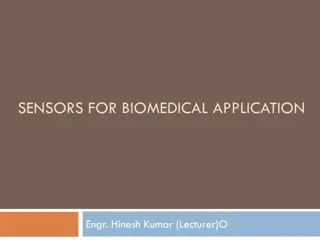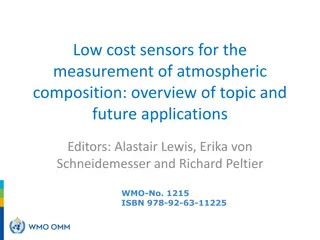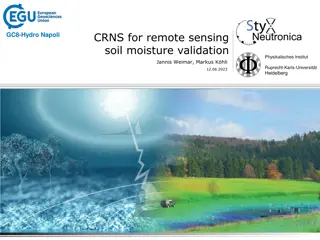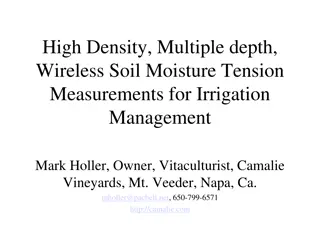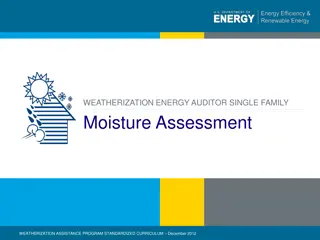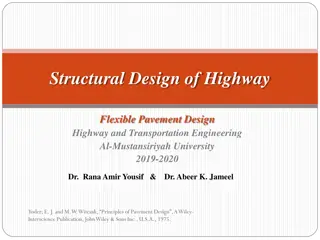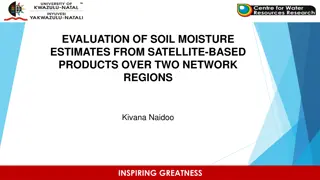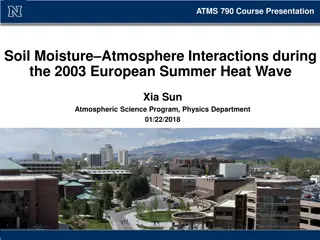Assessing the Value of Low Cost Versus High Cost Soil Moisture Sensors
The study compares the value of low-cost and high-cost soil moisture sensors for precision agriculture, focusing on reliability, accuracy, and noise levels. Various sensor technologies and their prices are evaluated, shedding light on the benefits and drawbacks of different sensors in agricultural applications.
- Soil moisture sensors
- Precision agriculture
- Sensor technologies
- Agriculture research
- Moisture sensing
Download Presentation

Please find below an Image/Link to download the presentation.
The content on the website is provided AS IS for your information and personal use only. It may not be sold, licensed, or shared on other websites without obtaining consent from the author. Download presentation by click this link. If you encounter any issues during the download, it is possible that the publisher has removed the file from their server.
E N D
Presentation Transcript
Assessing the Value of Low Cost Versus High Cost Soil Moisture Sensors Sam Noel, Dennis R. Buckmaster, James Krogmeier, Aaron Ault Agricultural and Biological Engineering Department, Purdue University Financial support from USDA-NIFA Proposal Number 2011-05096
Motivation Current practice: few expensive sensors per field Precision agriculture: more sensors for site-specific management Wanted to understand Different soil moisture sensing technologies Reliability Accuracy/precision Noise http://msucares.com/news/releases/14/nr20141120.html http://www.valmont.com/valley-irrigation/us/mediaroom/photos http://www.virtualoptimizer.com/
Sensors Steven s Hydra Probe Decagon EC-5 Vegetronix VH-400 wRobot Resistive Watermark 200SS Delmhorst GB-1 Sensing Technology: Capacitive Volumetric Water Content Price: $400 Other Info: Also senses electrical conductivity and soil temperature
Sensors Steven s Hydra Probe Decagon EC-5 Vegetronix VH-400 wRobot Resistive Watermark 200SS Delmhorst GB-1 Sensing Technology: Capacitive Volumetric Water Content Price: $100
Sensors Steven s Hydra Probe Decagon EC-5 Vegetronix VH-400 wRobot Resistive Watermark 200SS Delmhorst GB-1 Sensing Technology: Capacitive Volumetric Water Content Price: $40 Other Info: Most inexpensive sensor with capacitive technology
Sensors Steven s Hydra Probe Decagon EC-5 Vegetronix VH-400 wRobot Resistive Watermark 200SS Delmhorst GB-1 Sensing Technology: Resistive Volumetric Water Content? Price: $5 Other Info: Hobby sensor for use with Arduino, etc. http://ecx.images-amazon.com/images/I/41LX%2B14CqXL.jpg
Sensors SMX Chip Steven s Hydra Probe Decagon EC-5 Vegetronix VH-400 wRobot Resistive Watermark 200SS Delmhorst GB-1 Sensing Technology: Resistive Water Potential Price: $40-60 Other Info: Very popular in industry. Required the SMX chip(EME systems) for analog voltage output and DC supply. http://www.emesystems.com/smx.htm
Sensors Steven s Hydra Probe Decagon EC-5 Vegetronix VH-400 wRobot Resistive Watermark 200SS Delmhorst GB-1 Sensing Technology: Resistive Water Potential Price: $10 Other Info: Gypsum block construction. A resister divider circuit was breadboarded up to provide voltage output.
Soil Loam Northwest Clinton County, Indiana Upper 8 of soil Crop residue was removed, dug with shovel and placed into buckets Sharkey Clay 1 Bucket Steven s Hydra Probe Quite challenging
Bucket Apparatus 5-gallon bucket Airtight lid Hole in the bottom with cork Landscape fabric in the bottom to retain the soil when cork is pulled Hole in side to route the wire 12 inches of soil Sensors installed at 6-inch depth
Bucket Apparatus Calculations of volumetric water content Scale description
Equilibration Experiment relies on the equilibration Unevenly distributed moisture will ruin the experiment
Data Logging 2 DAQs (NI USB-6009s) 8 analog input channels each USB connected to PC 2 supply voltages 3.3 V Decagon EC-5, Vegetronix VH400, Watermark 200S, wRobot 10 V Steven s, Delmhorst GB-1
Pretest 2 sensors in a single bucket at different depths 3 depth and 9 depth
Pretest Results Realized moisture isn t distributed perfectly even in the soil (was wetter at the bottom) Discovered top sensors responded quickly as water washed over them, then receeded as water continued through. Bottom sensor had a delay and monotonically increased to true value. Depth affects curve s shape Figure out the time to allow for equilibration
Main Test Setup 6 Sensors 2 replications (12 buckets) 1 kg of water (~5% GWC) 5 day period to reach equilibration Weigh buckets to get corresponding GWC
Results Vegetronix VH400 One was bad as soon as water hit it, it must have shorted out Other went haywire about half way through the test
Results Watermark 200SS http://nrcca.cals.cornell.edu/soil/CA2/CA0211.5.php
Results Delmhorst GB-1 Looks like it was sensitive only in the low range
Conclusions Installation matters True equilibration is difficult
Future Work What we would do different Add smaller increments of water Subset of sensors and more replications Other depths Other soils (clay soil)
Acknowlegements Financial support from USDA-NIFA Proposal Number 2011-05096 Soil moisture sensors from Doug Hackney, Enterprise Group, Ltd., Tyler McClendon and Garrett McClintock, Oxbow Agriculture
